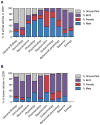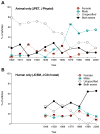Sex bias in neuroscience and biomedical research
- PMID: 20620164
- PMCID: PMC3008499
- DOI: 10.1016/j.neubiorev.2010.07.002
Sex bias in neuroscience and biomedical research
Abstract
Female mammals have long been neglected in biomedical research. The NIH mandated enrollment of women in human clinical trials in 1993, but no similar initiatives exist to foster research on female animals. We reviewed sex bias in research on mammals in 10 biological fields for 2009 and their historical precedents. Male bias was evident in 8 disciplines and most prominent in neuroscience, with single-sex studies of male animals outnumbering those of females 5.5 to 1. In the past half-century, male bias in non-human studies has increased while declining in human studies. Studies of both sexes frequently fail to analyze results by sex. Underrepresentation of females in animal models of disease is also commonplace, and our understanding of female biology is compromised by these deficiencies. The majority of articles in several journals are conducted on rats and mice to the exclusion of other useful animal models. The belief that non-human female mammals are intrinsically more variable than males and too troublesome for routine inclusion in research protocols is without foundation. We recommend that when only one sex is studied, this should be indicated in article titles, and that funding agencies favor proposals that investigate both sexes and analyze data by sex.
Copyright © 2010 Elsevier Ltd. All rights reserved.
Figures




Similar articles
-
Female mice liberated for inclusion in neuroscience and biomedical research.Neurosci Biobehav Rev. 2014 Mar;40:1-5. doi: 10.1016/j.neubiorev.2014.01.001. Epub 2014 Jan 20. Neurosci Biobehav Rev. 2014. PMID: 24456941
-
Sex bias and omission in neuroscience research is influenced by research model and journal, but not reported NIH funding.Front Neuroendocrinol. 2020 Apr;57:100835. doi: 10.1016/j.yfrne.2020.100835. Epub 2020 Feb 15. Front Neuroendocrinol. 2020. PMID: 32070715 Free PMC article. Review.
-
Problems and Progress regarding Sex Bias and Omission in Neuroscience Research.eNeuro. 2017 Nov 9;4(6):ENEURO.0278-17.2017. doi: 10.1523/ENEURO.0278-17.2017. eCollection 2017 Nov-Dec. eNeuro. 2017. PMID: 29134192 Free PMC article.
-
Sex Inclusion in Transcriptome Studies of Daily Rhythms.J Biol Rhythms. 2023 Feb;38(1):3-14. doi: 10.1177/07487304221134160. Epub 2022 Nov 23. J Biol Rhythms. 2023. PMID: 36419398 Free PMC article.
-
Sex bias in alcohol research: A 20-year comparative study.Front Neuroendocrinol. 2021 Oct;63:100939. doi: 10.1016/j.yfrne.2021.100939. Epub 2021 Aug 16. Front Neuroendocrinol. 2021. PMID: 34411573 Review.
Cited by
-
Sex Differences in Hierarchical and Modular Organization of Functional Brain Networks: Insights from Hierarchical Entropy and Modularity Analysis.Entropy (Basel). 2024 Oct 14;26(10):864. doi: 10.3390/e26100864. Entropy (Basel). 2024. PMID: 39451941 Free PMC article.
-
Exploring the Impact of Sex and Gender in Brain Function: Implications and Considerations.Adv Ther. 2024 Oct 23. doi: 10.1007/s12325-024-03016-3. Online ahead of print. Adv Ther. 2024. PMID: 39443404
-
Inclusion, reporting and analysis of demographic variables in chronobiology and sleep research.Front Neurosci. 2024 Sep 16;18:1421026. doi: 10.3389/fnins.2024.1421026. eCollection 2024. Front Neurosci. 2024. PMID: 39351394 Free PMC article. Review.
-
Nerve growth factor gene polymorphisms may be associated with heroin dependence in women but do not mediate specific personality traits.Eur Arch Psychiatry Clin Neurosci. 2024 Sep 23. doi: 10.1007/s00406-024-01906-9. Online ahead of print. Eur Arch Psychiatry Clin Neurosci. 2024. PMID: 39311999
-
The Promise and Practicality of Addressing Sex as a Biological Variable and the Ovarian Cycle in Preclinical Epilepsy Research.Epilepsy Curr. 2024 Jul 25;24(4):274-279. doi: 10.1177/15357597241261463. eCollection 2024 Jul-Aug. Epilepsy Curr. 2024. PMID: 39309055 Free PMC article.
References
-
- Anastos K, Charney P, Charon RA, Cohen E, Jones CY, Marte C, Swiderski DM, Wheat ME, Williams S. Hypertension in women: what is really known? The women’s caucus, working group on women’s health of the Society of General Internal Medicine. Ann Intern Med. 1991;115:287–293. - PubMed
-
- Andreano JM, Cahill L. Sex influences on the neurobiology of learning and memory. Learn Mem. 2009;16:248–266. - PubMed
-
- Barrett-Connor E. Sex differences in coronary heart disease. Why are women so superior? The 1995 Ancel Keys lecture. Circulation. 1997;95:252–264. - PubMed
-
- Beach FA. Animal models for human sexuality. Ciba Found Symp. 1978:113–143. - PubMed
Publication types
MeSH terms
Grants and funding
LinkOut - more resources
Full Text Sources
Miscellaneous

